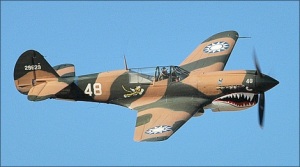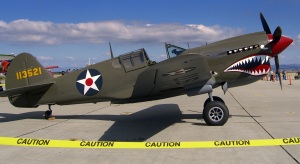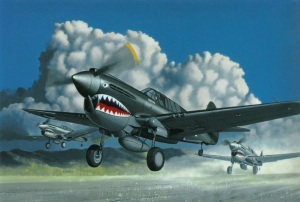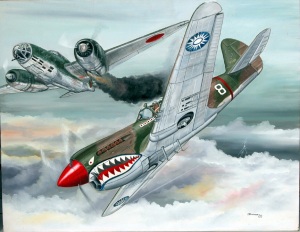This week’s plane of the week is the Curtiss P-40 Warhawk.
The Curtiss P-40 Warhawk was an American single-engined, single-seat, all-metal fighter and ground-attack aircraft that first flew in 1938. The P-40 design was a modification of the previous Curtiss P-36 Hawk which reduced development time and enabled a rapid entry into production and operational service. The Warhawk was used by most Allied powers, especially the United States and England, during World War II, and remained in frontline service until the end of the war. It was the third most-produced American fighter, after the P-51 and P-47; by November 1944, when production of the P-40 ceased, 13,738 had been built, all at Curtiss-Wright Corporation’s main production facilities at Buffalo, New York.
Early combat operations pointed to the need for more armor and self-sealing fuel tanks, which were included in the P-40B. These improvements came at price: a significant loss of performance due to the extra weight. Further armor additions and fuel tank improvements added even more weight in the P-40C. Curtiss addressed the airplane’s mounting performance problems with the introduction of the P-40D (Kittyhawk Mk I), which was powered by a more powerful version of the Allison V-1710 engine, and had two additional wing-mounted guns. The engine change resulted in a slightly different external appearance, which was the reason the RAF renamed it from the Tomahawk to the Kittyhawk. Later, two more guns were added in the P-40E, and this version was used with great success by General Claire Chenault’s American Volunteer Group in China.
Colonel Claire Lee Chennault had been in China since the mid-Thirties. An outspoken advocate of “pursuit” (as fighter planes were called then), in an Army Air Force dominated by strategic bomber theorists, he alienated many of his superiors. But in China, equipped with P-40’s, he developed the basic fighter tactics that American pilots would use throughout the war. The Japanese planes used over China were much more maneuverable than his Warhawks, whose advantages were speed in a dive, superior firepower, and better ability to absorb battle damage. Chennault worked out and documented the appropriate tactics that capitalized on the relative strengths of the American fighters: intercept, make a diving pass, avoid dogfighting, and dive away when in trouble. This remained the fundamental U.S. fighter doctrine throughout the Pacific War. Chennault’s American Volunteer Group, popularly known as “The Flying Tigers” flew their P-40B’s and P-40C’s with great success against the Japanese aircraft. They were probably the most famous pilots of the P-40.
The AVG never had more than three squadrons of 18 P-40s at any time. Flying their first combat mission on December 20, 1941, the Flying Tigers operated under extremely difficult conditions at the end of the world’s longest supply line — and with the war’s lowest supply priority. Nevertheless, by the time the group disbanded six months later, its pilots had shot down 286 Japanese aircraft. During a period in the war when everybody else in the Far East was being soundly defeated by the Japanese, their achievements were truly phenomenal.
It is unfortunate that, even with all its victories, the P-40 appears on many people’s “worst fighters of WW II” list. At best it is considered mediocre. Even though it served brilliantly, frequently fighting against the odds, and amassed an exceptional kill to loss ratio, it is still often thought of as a slow, unmanuverable, and obsolescent fighter. It fought in the Pacific against overwhelming enemy numbers, flying in some of the harshest conditions to be found on earth, and held the line for two years, until newer planes could be brought into service. After all that, it defended other (smaller) countries for several more years. It really wasn’t as bad as it was made out to be.
Next week: in Soviet Russia, the plane flies you!





